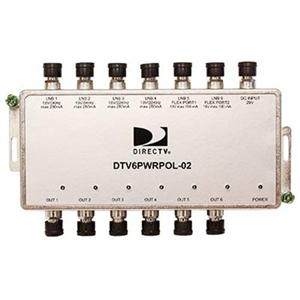What you see above you is a polarity locker. In fact it’s this polarity locker. You may remember it from my exciting exposé on polarity lockers back in 2016. The question today is, should you have one in your home? Is it a worthwhile expense?
Real quick, what does a polarity locker do?
A polarity locker takes each of the six outputs from a dish and sets them up so that only one signal can possibly travel down it. With a polarity locker you know for absolute sure which signal is on which cable. Without that it’s possible that things could get confused. See, without a polarity locker, the receivers or SWM is free to request whichever signal it wants and the dish sends that signal down the line.
Well, actually, that is only true for four of the six signals on a modern LNB. The other two are used only for reverse band signals, but I’m getting ahead of myself here.
Another function of a modern polarity locker is to provide power for the dish. This is important if the dish is far from the SWM or receiver, and it’s also important for commercial installations so no one receiver or SWM can take down the whole system.
Why is a polarity locker important?
The real satellite diehards would tell you that the signal coming off the polarity locker is cleaner and better than the signal coming in. There’s no chance of stray signals and you’re getting exactly the signal you want and nothing else. Yeah, that’s basically true but it’s probably less important than you think in most cases.
Polarity lockers are important in large installations so that the signals always stay on the same line. This is critical with multiple SWMs. Without that you run the risk of the wrong signal being sent due to someone hooking up a SWM wrong. This sort of problem is very very hard to find and fix.
The other part, powering the dish, is also really important for commercial installations. You would put this polarity locker within a few feet of the dish so that it always gets clean power. Then you would connect an amplifier after that so that the signal running to the master closet is nice and strong.
But at home?
There are going to be some old-school folks out there who tell you that they have an amplifier and polarity locker at home. They’ll tell you they believe it helps their rain fade issues or whatnot. I suppose that’s possible in a very narrow set of circumstances but in general I just don’t recommend polarity lockers for home use. The simple fact is they’re not necessary.
Polarity lockers and SWM
If you have a polarity locker, you’re committing to using an external SWM. That’s fine if you planned on doing that anyway. An external SWM can help you plan the DIRECTV system of your dreams, with as many receivers and Genie clients as you could want.
However, for most folks, the 13 tuners supplied by the standard reverse band satellite dish is going to be plenty. That’s enough for a Genie 2 to serve 7 rooms, or enough to supply 13 rooms with receivers. With this type of installation, there is a lot less wiring and a lot fewer headaches. And, there’s no place for a polarity locker to even go in the chain.
So here’s the final word: a polarity locker is a piece of equipment that should be in every commercial install, but it just isn’t needed at home.





